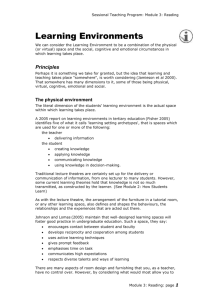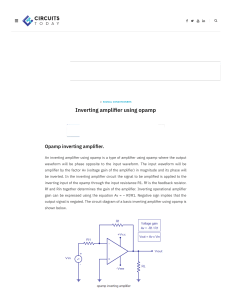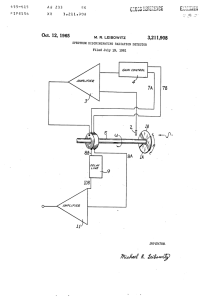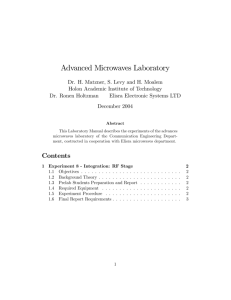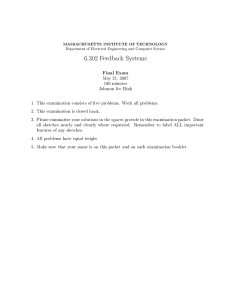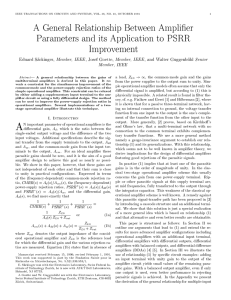1. Introduction - facta universitatis
advertisement
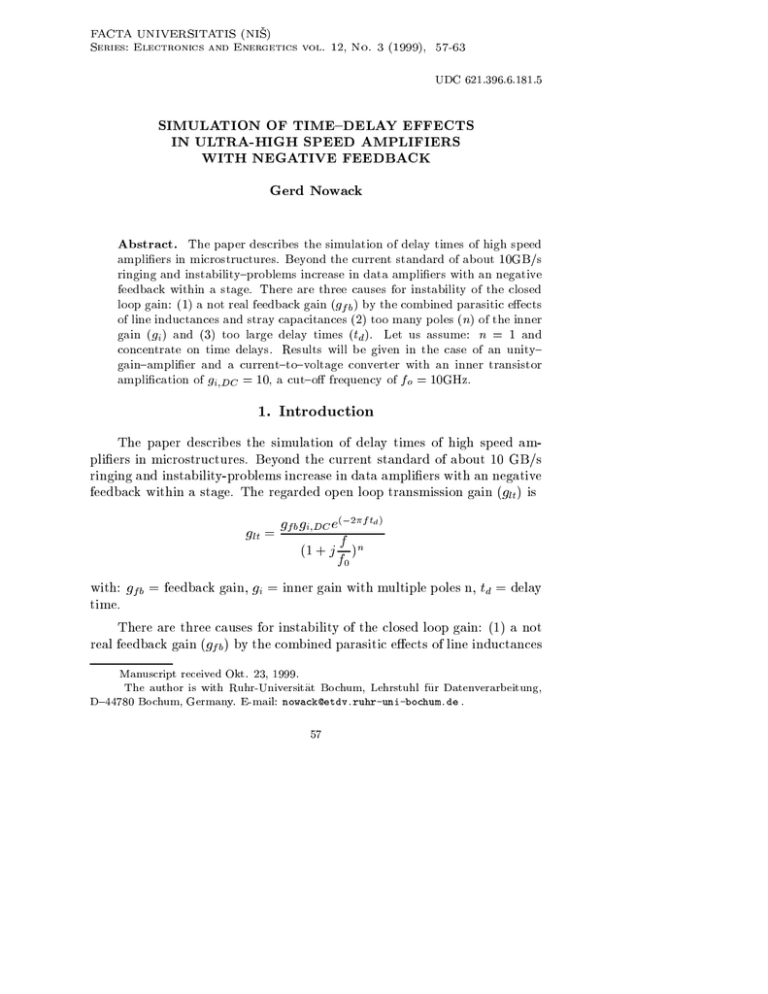
FACTA UNIVERSITATIS (NIS )
Series: Electronics and Energetics vol. 12, No. 3 (1999), 57-63
UDC 621.396.6.181.5
SIMULATION OF TIME{DELAY EFFECTS
IN ULTRA-HIGH SPEED AMPLIFIERS
WITH NEGATIVE FEEDBACK
Gerd Nowack
Abstract. The paper describes the simulation of delay times of high speed
ampliers in microstructures. Beyond the current standard of about 10GB/s
ringing and instability{problems increase in data ampliers with an negative
feedback within a stage. There are three causes for instability of the closed
loop gain: (1) a not real feedback gain (gfb ) by the combined parasitic eects
of line inductances and stray capacitances (2) too many poles (n) of the inner
gain (gi ) and (3) too large delay times (td ). Let us assume: n = 1 and
concentrate on time delays. Results will be given in the case of an unity{
gain{amplier and a current{to{voltage converter with an inner transistor
amplication of gi;DC = 10, a cut{o frequency of fo = 10GHz.
1. Introduction
The paper describes the simulation of delay times of high speed ampliers in microstructures. Beyond the current standard of about 10 GB/s
ringing and instability-problems increase in data ampliers with an negative
feedback within a stage. The regarded open loop transmission gain (glt ) is
,2ftd )
glt = gfb gi;DC e f
(1 + j f )n
0
with: gfb = feedback gain, gi = inner gain with multiple poles n, td = delay
(
time.
There are three causes for instability of the closed loop gain: (1) a not
real feedback gain (gfb ) by the combined parasitic eects of line inductances
Manuscript received Okt. 23, 1999.
The author is with Ruhr-Universitat Bochum, Lehrstuhl fur Datenverarbeitung,
D{44780 Bochum, Germany. E-mail: nowack@etdv.ruhr-uni-bochum.de .
57
58
Facta Universitatis ser.: Elec. and Energ. vol. 12, No.3 (1999)
and stray capacitances (2) too many poles (n) of the inner gain (gi ) and
(3) too large delay times (td ). Let us assume: n = 1 and concentrate on
time delays. Results will be given in the case of an unity-gain-amplier
and a current-to-voltage converter with an inner transistor amplication of
gi;DC = 10, a cut-o frequency of fo = 10GHz.
1. Theory of Negative
Feedback{controlled Circuits
The principle problem can be described by the simulation of negative
feedback structures. Figure 1 shows the schematic circuit diagram of a
closed-loop amplier.
Coupling System of
the inner Amplifier
IN
+
gcs
Ii
Vd
Error
gi
-
Vi
OUT
g fb
Feedback
Signal
alternative
Vo
Feedback
Transfer
System
Fig. 1. Schematic circuit diagram of a closed-loop amplier
The closed-loop gain is given by
A = gcs 1 ,ggi g
fb i
with
(1)
gcs = VVd V =0 and gfb = VVd V =0
i
o
o
i
This amplication of closed-loop systems can be normalized by the idealized gain under the condition of innite inner gain gi
gcs
A1 = gilim
!1 A = , g
fb
(2)
G. Nowack: Simulation of Time{delay Eects in ...
The normalized closed-loop gain is
A = 1
A1 1 , 1
gfb gi
= 1 1 = EF
1, g
59
(3)
lt
The relation between the real and the desired amplication is given by
the error factor (EF), which depends only on the loop transmission gain:
glt = gfb gi with gfb as a complex transfer function of the feedback network
and the inner amplication factor gi :
,2ftd
gi = gi;DC e f
(1 + j f )n
(4)
o
2. The Optimized Structure of
Negative Feedback Amplier
The best implemented amplier has to be adapted to theoretical concepts as good as possible. The buer amplier (unity gain amplier) as the
current-to-voltage converter have severe problems because of their 100 %
negative feedback. There are many discrepancies to the ideal concept, mainly
in the region of medium frequencies: The transition region between low and
high frequencies will mainly determined by the phase margin:
' 90
asymptotic transition
'Res;T = 64:83
aperiodic limit: Increase of amplication to jAj = 1
0 < 'Res;T < 64:83 not acceptable peak in the transition function: jAj 1;
'Res;T 0
unstable amplier, oscillator
3. Instability of the Unity
Gain Amplier
The problems of multiple poles (n) is well known in literature. In this
treatment n should be a variable real number, that means a "variable phase
shift" in the open-loop gain. In this case there is a good approximation of
the open-loop gain with dierent cut-o frequencies near the critical transit
frequency. Figure 2a shows the result of the variation of n in the case of the
unity gain amplier very impressive. The inner transistor amplication is
gi;DC = 10, and the cut-o frequency fo = 10GHz.
60
Facta Universitatis ser.: Elec. and Energ. vol. 12, No.3 (1999)
(a)
(b)
Fig. 2. Frequency response in the case of destabilisation by
(a) multiple poles n, (b) delay times td
With n = 1:47 the increase of amplication to the desired value of 1 can
be reached (aperiodic case). The enlargement of n results in a lower phase
margin at the transit frequency of the open-loop gain.
The problems of delay times in circuit layout are undervalued in literature. The result is a lower phase margin at the transit frequency. An unavoidable pole in the open-loop gain will add a phase shift of 90 maximum.
In the case of delay times phase shifting is unlimited without reducing the
absolute value of the open-loop gain (which would improve the phase margin). Figure 2b shows the frequency response of the amplication under the
inuence of destabilisation by delay times.
It is possible to interpret the delay time as transit time over a geometrical length L. (Look at gure 3.) It depends on the velocity of the
G. Nowack: Simulation of Time{delay Eects in ...
61
electromagnetic waves. The formula is
L = vtd
with v = c=pr "r , c is velocity of light and r = 1.
Fig. 3. Delay time caused by geometric length, dierent substrates
The consequence of these small geometric dimensions, all in the submillimeter range, is the implementation of the circuits in the technology of
microelectronics. This is necessary even if the feedback is applied only to one
stage just as emitter-follower or current-to-voltage converter. It is obvious
that in the frequency range of 10 to 100GHz the boundaries of technology
in microelectronics will be reached so that negative feedback is possible only
in a moderate amount, that means lower than 100 % to improve the phase
margin of the loop.
4. Moderate Negative Feedback
in Ultra Fast Receivers
The regarded circuits in the last chapter have a feedback gain near ,1.
The negative feedback is about 100%. In this case, the inuence of parasitic elements is dramatically large. The structure of these circuits prevents
the reduction of feedback to a moderate value with more phase reserve, in
principle. Therefore TISs and EFs are not suitable for ultra-high frequency
applications. Negative feedback will be necessary in any case, of course. But
the feedback gain should be chosen nearby zero at rst. Then the increase
of feedback gain will improve all specications by the ratio of open-loop gain
62
Facta Universitatis ser.: Elec. and Energ. vol. 12, No.3 (1999)
Ii
Current
Mirror
with
Current
Gain
βI i
Base
Circuit
R a βI i
Emitter or
Cascode
Circuit with
matched Rc
Vo
Line
Fig. 4. Proposed transceiver circuit without TISs and Efs [6]
divided by closed-loop gain. But there is the risk of ringing and instability
every time. Figure 4 shows the proposed transceiver circuit without TISs
and EFs.
The detector current will be gained as much as possible by unsymmetrical current mirrors. The following simple base circuit has no negative feedback structure. Nevertheless, the cuto frequency of the current-to-voltage
conversion factor is near to the transition frequency of the current gain of
the transistor. Last stage should be a stage which is suitable for matching
the characteristic impedance of the connected lines as good as possible. The
cascode circuit is the best one because it is suppressing the Miller eect very
well.
In any case feedback structures have to be regarded with greatest attention. The given theoretical background helps to analyze the problem and
to nd a better solution. Optimal circuits have a tuning feedback struture
to realize an aperiodic behaviour. The presented methods could be applied
to all ultra-fast electronic circuits like ampliers or buers.
Aknowledgment
Gratefully I would acknowledge Professor Wolfgang Weber for stimulating research with good ideas in simulating and controlling technical systems.
REFERENCES
1. M. Schroter and H.-M. Rein: Investigation of very fast and high-current transients in digital bipolar IC's using both a new compact model and device simulator.
IEEE Journal of solid state circuits, Vol. 30, No. 5, May 1995
2. H.-M. Rein and M. Moller: Design Considerations for very-high-speed Si-bipolar
IC's operating up to 50 Gb/s. IEEE Journal of solid state circuits, Vol. 31, No. 8,
August 1996
3. H.-M. Rein, E. Gottwald and T.F. Meister: Si-bipolar - a potential candidate
for high speed electronics in 20 and 40 Gb/s TDM systems. Spring topical meetings,
G. Nowack: Simulation of Time{delay Eects in ...
63
ultrafast electronics and optoelectronics, March 17-19, 1997, Incline Village, Nevada,
USA (Invited paper)
4. R. Heidemann, B. Wedding and G. Veith: 10 Gb/s transmission and beyond.
Proceedings of the IEEE, Vol. 81, No. 11, Nov. 1993
5. H. Morkoc: Modulation-doped FETs providing gain at 250 GHz and oscillating at
frequencies well above, extend the horizons of high performance circuits, from signal
processing to space. IEEE Circuits & Devices, Nov. 1991
6. G. Nowack: Ultra-high Speed Mechanisms of Amplication and Conversion in optical Wide Area Networks. International Conference on Informational Networks and
Systems: ICINAS-98, 7.-12. September 1998, Sankt Petersburg, Russia, Proceedings: 66 - 74

